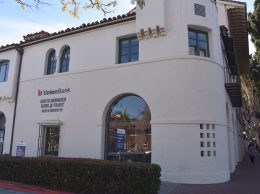Remembering the banking visionary who built SBB&T
IN THIS ARTICLE
- Banking & Finance Topic
- Henry Dubroff Author
By Henry Dubroff Tuesday, December 23rd, 2014
He was the son of a son of a banker. And perhaps the most important figure in banking on the Central Coast in the past half-century.
Donald M. Anderson, a Minnesota native whose vision drove Santa Barbara Bank & Trust’s rise to the top of the region’s financial institutions, died earlier this month in Santa Barbara. He was 86.
Anderson’s folksy manner and affable demeanor fit in well on the Central Coast. But he combined his great social skills and a terrific golf game with a sharp mind, sound judgment and relentless determination.
“He was very competitive. He wanted the organization to win,” David Spainhour, a longtime colleague who succeeded Anderson at the helm of SBB&T’s parent, said in a video tribute to Anderson made several years ago.
Anderson worked in family-owned banks as a youngster, and attended college and graduated from Harvard Business School.
After trying his hand in sales and stock brokerage, he returned to banking. A rising start at Norwest Bank, Anderson was lured to Santa Barbara in the late 1960s on the promise of a plane ticket to get out of the cold Minnesota winter.
By 1972 he was president of SBB&T, which embarked on a growth period that turned it into the most important financial institution on the Central Coast. It dominated South Santa Barbara County for loans and deposits and used a combination of mergers and de novo branches to extend from Monterey County to Westlake Village. Renamed Pacific Capital Bancorp., it was recognized as the dominant financial institution in the region.
All the while Anderson kept the company’s focus on its employees, its communities and its customers.
“He bet on people’s potential,” said hotel owner Tony Romasanta in the video. “His loans made people more successful than they otherwise might have been.”
An extraordinary gift for situational awareness led Anderson to pick up business from large banks that were going through tough times in the early 1990s.
Anderson was no longer running the bank when the Business Times was getting off the ground in March 2000. But I had an opportunity to meet with him at his home near La Cumbre Country Club and learn a few things about the nature of business on the Central Coast.
In his view, business cycles were more muted in our region but they happened nonetheless. Reputation mattered more and the area had a way of eliminating the bad actors. The promise of the region was great, in part because the tension between growth advocates and preservationists raised barriers to entry and created natural franchises.
The foundation Anderson laid for SBB&T was tested by the financial crisis — despite a flawed technology upgrade that cost millions and disastrous exercise in making out-of-region loans — the bank was still able to attract a $500 million investment and eventually it was merged with Union Bank.
In his time, Anderson was a force to be reckoned with in Central Coast banking. Those who worked with him or did business with him were much better off for the experience.












